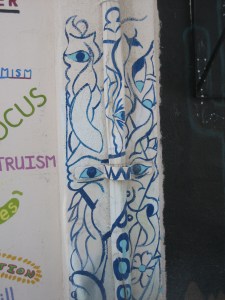The Cabeza Prieta Visitor Center is located at 1611 North Second Street (Highway 85) in Ajo, Arizona. The refuge’s website says,
It is open Monday through Friday from 8am to 4pm. Here, refuge staff and volunteers are available to provide you with maps, brochures and checklists and let you know what’s happening on the refuge.
I visited the Cabeza Prieta Visitor Center in early May, when it was already hot outside. I spent most of my time looking at the inside exhibits, but I looked around outside a bit too.
Cabeza Prieta, Spanish for “dark (or dirty) head,” refers to a lava-topped, granite peak in a remote mountain range in the western corner of the refuge.
Secondly, the Visitors Center is just a tiny piece of what Cabeza Prieta is for and about. The  aforementioned website says,
aforementioned website says,
Cabeza Prieta National Wildlife Refuge encompasses 860,000 acres, a portion of which are open to the public for wildlife related activities including wildlife watching and photography, primitive camping, limited hunting, and environmental education and interpretation.
Almost all of the refuge is designated wilderness and it is part of the National Wildlife Refuge System, a national network of lands and waters set aside for the benefit of wildlife and you.
…Today, the refuge’s management priorities are primarily focused on the endangered Sonoran pronghorn, bighorn sheep and lesser long-nosed bat.
There are two main indoor exhibits at the visitor center, both in a room to the right of the entrance. When I visited, the room was dark, and I had to turn on the lights so I could have a look around.
The first attraction is a video about the refuge. When I stepped into the tiny theater, the video was not playing. A remote control sat on the bench next to me, but despite pushing the power and play buttons, I could not get the video to come on. I went through an open door to the front of the office area. No one was sitting at the main desk, but there was a bell there, so I rang it. A young woman came from the back, and I told her I wanted to watch the video but could not get it to play. She helped me, but acted mildly irritated, as if I were keeping her from her real work.
The video was informative, but I felt as if maybe it had picked up in the middle of the action. The weirdest part of the video was when some government employee guy talked about how the crust on the desert floor is a living organism while he plunged his knife into it and pulled up a piece of the crust to display to the camera. Ouch! I’m a living organism too, and I hope no one ever does that to me.
(Well, ok, Wikipedia says
[b]iological soil crusts are communities of living organisms on the soil surface in arid– and semi-arid ecosystems
so maybe what the guy did was not quite as bad as plunging a knife into me.)

This big cat was once alive, but now it’s dead. The sign says, “A Haven for Wildlife.” Well, this room is the opposite of a haven for wildlife. This room is more like a wildlife graveyard.
The other indoor exhibit is a display of desert creatures. The problem is that these desert creatures were once alive and now they are dead. I presume someone killed those animals so they could be displayed, then handed them over to a taxidermist to preserve them. I didn’t much like looking at animals that were once alive but now weren’t. It kind of gave me the creeps, especially the big, dark eyes of the dead pronghorn. I would rather look at photographs of desert creatures instead of their preserved remains.
I walked around a bit outside the Visitor Center. There are several trails to walk on, a few informational signs, and lots of cacti. There’s also a pond where Quitobaquito pupfish live, but that’s a story for another day.
There is also a bird hide in the back of the visitor center. Wikipedia says
[a] bird hide (or hide, also known as a blind or bird blind in North America) is a shelter, often camouflaged, that is used to observe wildlife, especially birds, at close quarters. Although hides or hunting blinds were once built chiefly as hunting aids, they are now commonly found in parks and wetlands for the use of bird watchers, ornithologists and other observers who do not want to disturb wildlife as it is being observed.
A typical bird hide resembles a garden shed, with small openings, shutters, or windows built into at least one side to enable observation.
The hide at the visitor center does look like a shed, and it has sliding panels over the windows. It overlooks a small pond. I went into the bird hide and opened one of the windows and looked out, but didn’t stay long. I was hot and hungry by that time, and I’m not all that excited about birds. The bird hide overlooks a small pond, so I’m sure it is a great place to watch birds taking a drink or having a bath.
The Cabeza Prieta Visitor Center was a fine place to spend some time. I was probably there a little more than an hour. Of course, I appreciated the lack of admission fee. I don’t know if I will ever visit the actual wilderness area, but the visitor center offers much information about the Sonoran Desert.
I took all of the photos in this post.
















































































